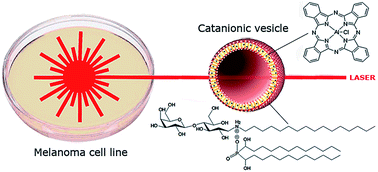Catanionic vesicles charged with chloroaluminium phthalocyanine for topical photodynamic therapy. In vitro phototoxicity towards human carcinoma and melanoma cell lines†
Abstract
The hydrophobic character of chloroaluminium phthalocyanine (ClAlPc) and its tendency to dimerize in aqueous media reduces its topical penetration as well as its photodynamic efficacy. Lactose-derived catanionic vesicles, spontaneously obtained by mixing oppositely charged surfactants, are proposed as an alternative to other drug delivery systems to tackle this difficulty. Spectrofluorimetry studies confirmed the good loading capacity of the catanionic vesicles. Dynamic light scattering experiments, in various physiological media, were carried out to evaluate the stability of the ClAlPc-loaded system. In vitro phototoxicity studies performed on both human carcinoma and melanoma cell lines with increased light doses that are commonly used in clinical trials, look promising for the success of photodynamic therapy using ClAlPc-loaded catanionic vesicles.


 Please wait while we load your content...
Please wait while we load your content...